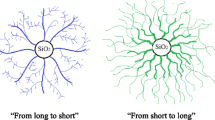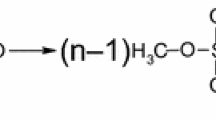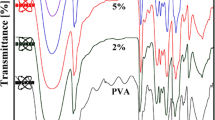Abstract
The present work involved a thorough study on silane-modified silica filler with special focus on its chemical interaction with polydimethylsiloxanes (PDMS) and the structural model of the modified filler. The samples prepared by addition of modified silica were characterized by Fourier transform infrared spectroscopy (FTIR), specific surface test, scanning electron microscopy (SEM) and fluorescent microscope. FTIR results confirmed the successful silica surface modification with silane coupling agent. The sample containing 80 phr (parts per hundreds of rubber) modified filler with weak ratio of Si–OH/Si–C group absorbance areas (A 1/A 0) showed weak formation of filler agglomerates while a stronger interfacial interaction could take place between the modified silica and PDMS. Specific surface results showed that the dispersion of silica can be improved when the amount of silane modifier to silica reached 2.0 wt%. SEM and fluorescent microscope showed that the filler aggregation was observed in cases of higher silica loading. As expected, when the silica with surface treatment was compared with those without surface modification, the filler particles were found to be fairly well dispersed in PDMS matrix.










Similar content being viewed by others
References
Osman MA, Atallah A, Müller M, Suter UW (2001) Reinforcement of poly(dimethylsiloxane) networks by mica flakes. Polymer 42:6545–6556
Rattanasom N, Saowapark T, Deeprasertkul C (2007) Reinforcement of natural rubber with silica/carbon black hybrid filler. Polym Test 26:369–377
Parker DD, Koenig JL (2000) Effect of pre-coated versus added coupling agents on the vulcanization of silica-filled polyisoprene. J Adhes 73:299–311
Yang K, Gu MY (2010) Enhanced thermal conductivity of epoxy nanocomposites filled with hybrid filler system of triethylenetetramine-functionalized multi-walled carbon nanotube/silane-modified nano-sized silicon carbide. Compos Part A-Appl S 41:215–221
Mathieu B, Marianna K, Khalil EM (2010) Effect of polymer/filler interactions on the structure and rheological properties of ethylene-octene copolymer/nanosilica composites. Polymer 51:5506–5515
Xue LJ, Li J, Fu J, Han YC (2009) Super-hydrophobicity of silica nanoparticles modified with vinyl groups. Colloids Surf A 338:15–19
Park SJ, Cho KS (2003) Filler-elastomer interactions: influence of silane coupling agent on crosslink density and thermal stability of silica/rubber composites. J Colloid Interface Sci 267:86–91
Ansarifar A, Azhar A, Ibrahim N, Shiah SF, Lawton JMD (2005) The use of a silanized silica filler to reinforce and crosslink natural rubber. Int J Adhes Adhes 25:77–86
Heinroth F, Münnekhoff R, Panz C, Schmoll R, Behnisch J, Behrens P (2008) The Sears number as a probe for the surface chemistry of porous silicas: precipitated, pyrogenic and ordered mesoporous silicas. Micropor Mesopor Mater 116:95–100
Kim H, Kim HG, Kim S, Kim SS (2009) PDMS-silica composite membranes with silane coupling for propylene separation. J Membr Sci 344:211–218
Ma XK, Lee NH, Oh HJ (2010) Surface modification and characterization of highly dispersed silica nanoparticles by a cationic surfactant. Colloids Surf A 358:172–176
Sudam KP, Sukalyan D, Sabita P, Mishr BK (2006) Adsorption of organic molecules on silica surface. Adv Colloid Interface Sci 121:77–110
Bokobza L, Leroy E (2009) Effect of filling mixtures of sepiolite and a surface modified fumed silica on the mechanical and swelling behavior of a styrene-butadiene rubber. Eur Polym J 45:996–1001
Fan LZ, Nan CW, Zhao SJ (2003) Effect of modified SiO2 on the properties of PEO-based polymer electrolytes. Solid State Ionics 164:81–86
Egashira M, Utsunomiya Y, Yoshimoto N, Morita M (2006) Effect of the surface treatment of the Al2O3 filler on the lithium electrode/solid polymer electrolyte interface properties. Electrochim Acta 52:1082–1086
Stevenson I, David L, Gauthier C, Arambourg L, Davenas J, Vigier G (2001) Influence of SiO2 fillers on the irradiation ageing of silicone rubbers. Polymer 42:9287–9292
Acknowledgments
This work has been supported by the Key Projects in the National Science & Technology Pillar Program during the Eleventh Five-Year Plan Period in China (2006BAB04A05).
Author information
Authors and Affiliations
Corresponding author
Rights and permissions
About this article
Cite this article
Liu, J., Wu, S., Zou, M. et al. Surface modification of silica and its compounding with polydimethylsiloxane matrix: interaction of modified silica filler with PDMS. Iran Polym J 21, 583–589 (2012). https://doi.org/10.1007/s13726-012-0062-x
Received:
Accepted:
Published:
Issue Date:
DOI: https://doi.org/10.1007/s13726-012-0062-x




